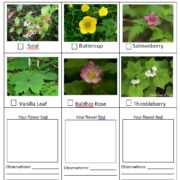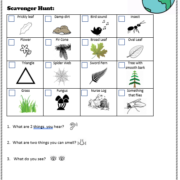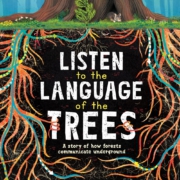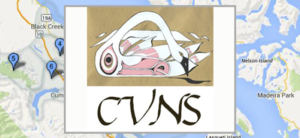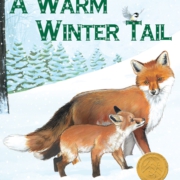Honorable Harvest -for students
Robin Kimmerer
Use the power of image recognition technology to identify the plants and animals all around you. Earn badges for seeing different types of plants, birds, fungi and more!
District approved app.
Printable
Winter/Spring Nature Scavenger Hunt
Printable
Bee’s & Pollinators
 Everything you need to know before keeping Mason Bee’s.
Everything you need to know before keeping Mason Bee’s.
Utilize this link to help guide you through caring for a mason bee house and mason bee’s. Below are some helpful resources to guide you through the process further. Remember Mason Bee ADS kits are now available in the district.
***David Suzuki Foundation Pollinators & Native Plants
*** VI Native Pollinator Plants – Guide
***SEED Bombs:
Materials
1 cup compost OR potting soil & compost mixture
1/2 cup of flour
1 tsp of seeds (or 1/2 tsp for very small seeds)
Instructions
1) First mix the compost and the flour together thoroughly.
2) Then add seeds and gently mix together
3) Add water one tablespoon at a time so that the mixture bonds together like a good dough. (Add more compost if mixture is too wet).
4) Once the mixture has the right consistency, divide mixture into small pieces and roll into a ball (small marble). A smaller seed ball is much more likely to have better contact with the soil and as the small ball crumbles it provides the start for the root system, but is still heavy enough to anchor the emerging seeds to the ground.
5) Let dry overnight or for 24 hours.
***Ideally, seed bombs should be made the day before rain is forecast and then cast 24 hours later – hopefully before the rain has started! If it doesn’t rain then no matter, the seeds will be fine for a few days.
Why Bee’s are disappearing
Mason Bees
Introduction to Solitaire Bees
How to keep Solitaire Bees
Tree’s & Forests
Imagine a forest full of trees. Each tree stands tall and solitary. It has its own trunk, branches and leaves. But did you know that those trees are connected by a complex network hidden underground?
Click the image to find some resources and video’s to bring to life the interconnectedness of trees working together as a community.
Vancouver Island Trees– This guide will help you identify some of the most common native trees found on Vancouver Island, British Columbia
SD71- INED link to Cedar Tree-The Tree of Life
Sierra Club- Mother Tree – Two eyes seeing approach to learning about the forest, Indigenous Ecological Knowledge and Scientific approach.
How to plant a Tree Seedling – Guide and tips to a successful planting of trees seedling planting in BC
DV8 Education: Connect with DV8 education in the Comox Valley for a supported program all about Trees.
HCTF-Education: Ready to use printable on trees- scroll to bottom of page
UBC Cool It!: Urban Forest’s and Climate Action-Lesson plans and hands on activities to explore our urban forest.
Project Learning Tree– Urban Forest Resource for educators
Comox Valley’s Trees of the Year nominations 2021- Map & article from Comox Valley Nature
Can you Hear the Trees Talking
By Peter Wohlleben
Are Trees Alive
By Debbie S. Miller
By Courtney Defriend
Fungi & Decomposers
Plant ID & Invasives
Printable
Seed balls are a great way to reclaim areas of your garden that have become thin or barren! The clay vessels that you create for your seeds and compost offer a fun way
to plant your seeds while providing protection for the exposed seeds.
Comox Valley- Naturalists Society
The Comox Valley Naturalist Society is made up of dedicated volunteers from scientists, stream-keepers to educators. They are committed to restoration and rehabilitation of our natural environmental around the Valley.
Broom Busting- Classroom Power Point resource, contact Broom Busters directly for access
The Comox Valley Broom Busters work in the areas of Courtenay, Cumberland, Comox and the CVRD. If you would like to find out more about Broom Busting in the Comox Valley, please contact Bev at cvbroombusters@gmail.com
Invasive Species Council of BC
ISCBC helps concerned stakeholders work together to stop the spread of invasive species in BC. This site has a search to find what species are invasive to your area and has a special youth/educators link.
Winter Wonders
Glacier Park- Winter Ecology Teachers Resource
Pintables & Lessons
A Warm Winter Tail
Over and Under the Snow
The Story of Snow
Under the Snow
Wild Kratts- Subnivean Zone
Explore Sierra Clubs EcoMap of BC to dive deeper into the flora & fauna of our amazing province. This EcoMap will help you learn about the amazing plant and animal beings in your ecoprovince and those of other ecoprovinces of BC, too! You can read about each being’s appearance, life cycle, the habitat they share with other beings, if they are endangered and other interesting information.
Nature Companion is a free app and website produced by EcoFriendly Sask that provides interesting and easy-to-understand information about >300 plants, trees, birds, animals, insects, reptiles, and amphibians found in Canada’s four western provinces.
Each short description includes colourful photographs and a Did you know? section with fun facts about each species. The tool is available on or offline and is a great way to connect kids with nature.
.png) Habitat and Conservation Trust Foundation – WildBC
Habitat and Conservation Trust Foundation – WildBC
Free well-established lesson ideas on a broad number of topics, Grades k-9
- Energy, Atmosphere, climate
- Earth, eco-systems, ecology
- Plants Animals Habitat
- Water, wetlands, Watersheds
- Outdoors Projects and places
- Teachers Tips and Tricks



.png)


